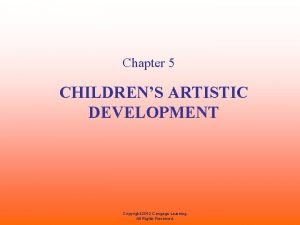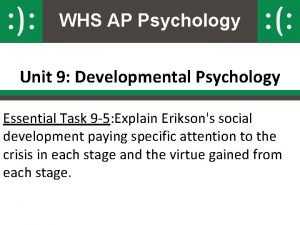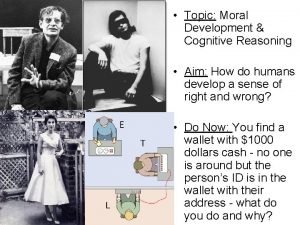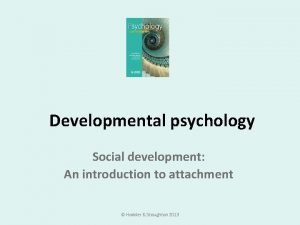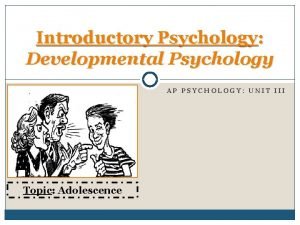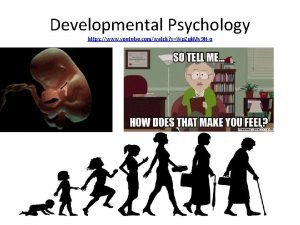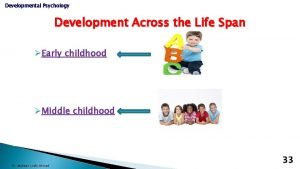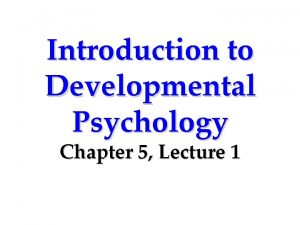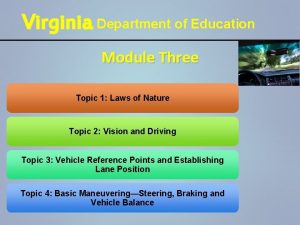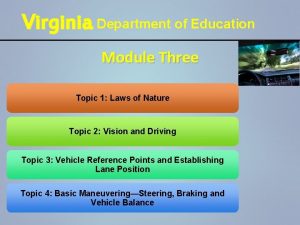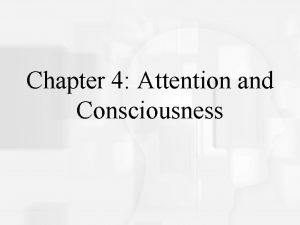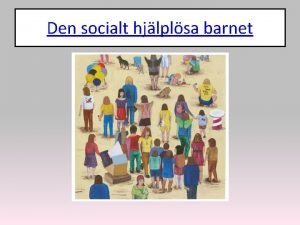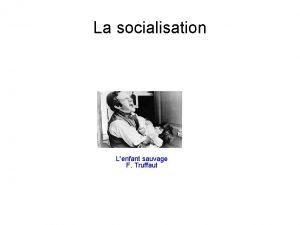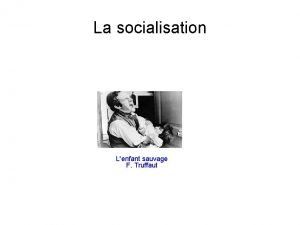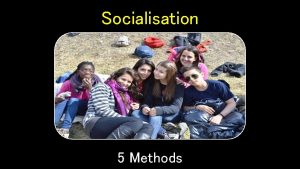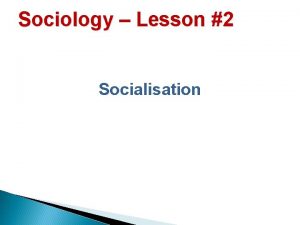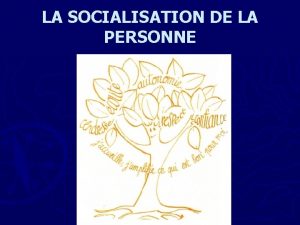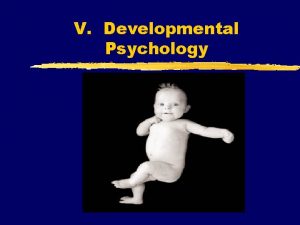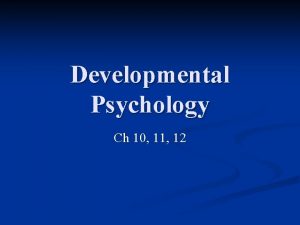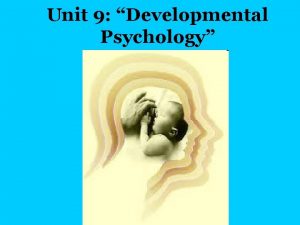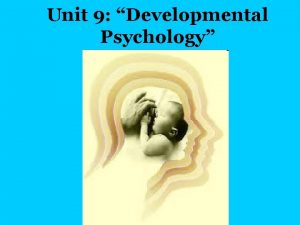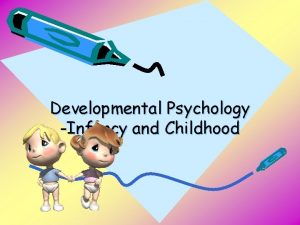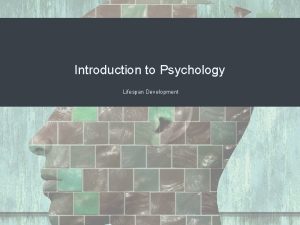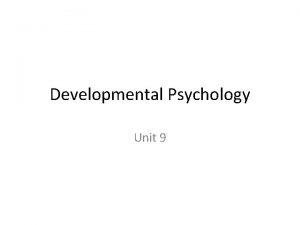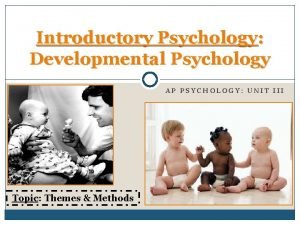EARLY SOCIALISATION Developmental Psychology THIS TOPIC COVERS Nature
























- Slides: 24

EARLY SOCIALISATION Developmental Psychology

THIS TOPIC COVERS. . . Nature of attachment and its role in early socialisation: behaviourist and psychoanalytic explanations of attachment, the Bowlby-Ainsworth paradigm, stages and types of attachment, multiple attachments The nature of separation, deprivation, privation; evidence from studies with animals and humans, long term implications for adjustment and mental health Day Care: factors affecting cognitive and social development of young children in day care.

NATURE http: //www. bing. com/videos/search? q=imprinting&vi ew=detail&mid=D 9 E 805685895 B 3 B 05802 D 9 E 8056 85895 B 3 B 05802&first=0&FORM=NVPFVR

WHAT IS ATTACHMENT? Bond between child and adult (Primary Attachment Figure, PAF) responsible for its care. Long term emotional bond. Separation causes stress and sadness. Behavioural feature –trying to maintain close proximity (Ainsworth and Bell, 1970). Key Features (Maccoby, 1980): Wanting close proximity to avoid distress Using attachment figure as basis for exploring the world (safety) Orienting behaviour towards figure – looking at them, facing them (focus)

STAGES OF ATTACHMENT (SCHAFFER, 1996) Pre-attachment – 0 -2 months – Enjoys social contact of any kind, no focus on carer. Attachment in the making – 2 -7 months- Starting to recognise individuals but still content with strangers. Specific Attachment – 7+ months – Separation protest when PAF leaves and begins to become anxious around strangers. Multiple Attachments – 9+ months - Begins to become attached to other figures but still has preference for PAF. Reciprocal Relationships – 8 -24 months – can predict and influence others responses.

SCHAFFER AND EMERSON, 1964 60 Glasgow infants – middle class families. M&P - Observed in their homes once every 4 weeks for a year and then again at 18 months. Attachment measured by asking mothers about separation protest. Measured levels of stranger anxiety by approaching the infant at the start of every observation and noting when they started to show signs of anxiety. R - Showed first specific attachment at 6 -8 months. 39% - PAF was not the person who fed and bathed them (as Behaviourists claimed). Little relation between strength of attachment and time spent with person. Strongest bonds were with mothers who reacted to infants responsively.

BEHAVIOURIST THEORY OF ATTACHMENT Attachment learned through conditioning Classical Conditioning = PAF is neutral stimulus Food (UCS) Pleasure (UCR) Feeder(CS) Operant Conditioning (Dollard and Miller) Negative reinforcement – stopping the discomfort of the baby through feeding/being fed The food is the primary reinforcer while the feeder is the secondary reinforcer.

EVALUATION Strong evidence support that people do learn through reinforcement – Little Albert. Is food the reward? What else could be the reward? Oversimplified Can’t explain Schaffer and Emerson’s findings.

PSYCHOANALYTIC THEORY Freud’s theory of development 0 -18 months the child is in the oral stage At this point only the id has been developed Motivated by being satisfying their need for food. Person who satisfies this becomes object of attachment.

EVALUATION Identifies why and who they become attached to. Difficult to prove or disprove. Lack of evidence.

CUPBOARD LOVE THEORIES Both of these theories are called Cupboard Love theories – focus on feeding. Contradicted by Schaffer and Emerson. Harlow (1959) Rhesus Monkey Study This showed that rather than learning through Classical Conditioning, infants have an innate need for comfort – contact comfort. If the attachments had been formed through feeding then the monkey would have clung to the wire figure.

THE BOWLBY-AINSWORTH PARADIGM Bowlby’s Theory – The evolutionary approach 1. Bowlby (1969) claimed that attachment was adaptive – born with a need to become attached in order to survive (be cared for as an infant) and reproduce (form relationships as adults). 2. Infants elicit caregiving (see next slide) 3. Adults respond to social releasers- attachments form due to the interactions. Infants only form one special relationship (monotropy) with the person they interact best with. 4. Internal working model – the relationship they have with their PAF determines what they expect from all relationships.


RESEARCH Imprinting – innate in animals for survival. Sensitive period – 6 months, after which infants find it difficult to form attachments. Supports Bowlby’s theory of attachment being adaptive. Schaffer and Emerson’s study also appears to support the idea of monotropy. Tronick et al (1992) African tribe – one PAF despite being breastfed by multiple women. Harlow’s monkeys all had trouble in adulthood – poor relationships and poor parents. Lack of interaction.

AINSWORTH’S CAREGIVER SENSITIVITY HYPOTHESIS (1967) Expresses importance of sensitivity. Uganda – mothers were more sensitive if they could recall lots of information about their children. These infants tended to be securely attached.

TYPES OF ATTACHMENT Secure – strong and content attachment. Results in a well developed adult. PAF responds sensitively to their infants needs. Insecure – PAF is insensitive to infants needs. Poor subsequent emotional and cognitive development. Insecure/Avoidant – child avoids social interaction. Insecure/resistant – Children both seek and reject social interaction.

AINSWORTH ET AL, 1978: THE STRANGE SITUATION STUDY. To observe separation and stranger anxiety as well as to test the secure base concept. The infant was observed in the following situations: (1) Parent and infant alone. (2) Stranger joins parent and infant. (3) Parent leaves infant and stranger alone. (4) Parent returns and stranger leaves. (5) Parent leaves; infant left completely alone. (6) Stranger returns. (7) Parent returns and stranger leaves. Exploring behaviour, separation anxiety, stranger anxiety and reunion behaviour were all recorded at 15 second intervals.

RESULTS Secure Insecure/Avoidant Insecure/ Resistent Separation Anxiety Distressed when mother leaves. Infant shows signs of intense distress when mother leaves. Infant shows no sign of distress when mother leaves. Stranger Anxiety Avoidant of stranger when alone but friendly when mother present. Infant avoids the stranger - shows fear of stranger. Infant is okay with the stranger and plays normally when stranger is present. Reunion behaviour Child approaches Positive and happy when mother but resists contact, may even mother returns. push her away. Other Will use the mother as a safe base to explore their environment. Infant cries more and Mother and stranger explores less than the are able to comfort other 2 types. infant equally well. % of infants 70 15 Infant shows little interest when mother returns. 15

HARRY POTTER Consider the 3 main characters in Harry Potter: Harry, Hermione and Ron. Categorise these characters in terms of their attachment style based on what you know from the films/novels. Justify your answer. If you have never watched or read Harry Potter pair up with someone who has and have them describe each character to you.

CONTINUITY HYPOTHESIS The effects of attachment last into adulthood Hazan and Shaver, 1987. ‘Love Quiz’ in a newspaper. � Securely attached – long lasting, trusting relationships. � Insecure – ambivalent (resistant) – Worried that their partners don’t love them. � Insecure – avoidant – Fear intimacy. Sroufe et al, 1999 Longitudinal study. Securely attached grew up to be more popular and rated higher for social competence.

TEMPERAMENT HYPOTHESIS (KAGAN, 1984) Opposes Bowlby’s theory. Claims that attachment is a result of infant being innately trusting and friendly (personality that you are born with) which shapes the mother’s responses. Belsky and Rovine, 1987 – Newborns who were difficult babies were less likely to become securely attached.

DIFFERENT KINDS OF ATTACHMENT Multiple attachments – for social learning (interacting with peers). Father attachments – Bowlby, 1951 – fathers there simply for financial and emotional support. Schaffer and Emerson, 1964 – fathers were PAF. � Accessibility – suggested that fathers tend not to be PAF because they don’t spend as much time with infant – Schaffer and Emerson, 1964 found that there was no correlation between attachment and time spent with infant. � A different kind of attachment – men are more challenging than women in their kind of play – not a secure base but positive and challenging.

CULTURAL SIMILARITIES If attachment is innate – there shouldn’t be any differences. Van Ijzendoorn and Kroonenberg (1988) – 32 studies of the Strange Situation in 8 countries. Secure most common in every country � This is the best attachment style for healthy relationships. � Tronick et al, 1992 (African tribe study) Still showed only one PAF. Fox, 1997 studies infants in Israel who spent most of their time in a children’s home. Still most closely attached to mother.

CULTURAL DIFFERENCES. Grossman and Grossman, 1991. German children tended to be insecurely attached. Childrearing style? – Interpersonal space so would make infants appear to be insecurely attached. Takahashi, 1990. Infants rarely separated from their mother so they may ‘appear’ to be more distressed than infants from other cultures.
 Social development in adulthood 19-45
Social development in adulthood 19-45 Kellogg's developmental stages of art for early childhood
Kellogg's developmental stages of art for early childhood Initiative vs guilt
Initiative vs guilt Lawrence kohlberg developmental psychology
Lawrence kohlberg developmental psychology Research methods in developmental psychology
Research methods in developmental psychology History of developmental ideas in psychology
History of developmental ideas in psychology What was john bowlby attachment theory
What was john bowlby attachment theory Personal fable ap psychology
Personal fable ap psychology Devonte is a graduate student in developmental psychology
Devonte is a graduate student in developmental psychology Unit 3 developmental psychology
Unit 3 developmental psychology Ucf online psychology
Ucf online psychology Sublimation psychology
Sublimation psychology Animism examples psychology
Animism examples psychology Chapter 5 developmental psychology
Chapter 5 developmental psychology Concluding sentence
Concluding sentence Narrow
Narrow Early cpr and early defibrillation can: *
Early cpr and early defibrillation can: * Module 3 topic 2 vision and driving
Module 3 topic 2 vision and driving Point proof analysis essay example
Point proof analysis essay example To kill a mockingbird 5 paragraph essay
To kill a mockingbird 5 paragraph essay Topic sentence about nature
Topic sentence about nature Ppe format essay
Ppe format essay Module 3 topic 1 laws of nature
Module 3 topic 1 laws of nature Rcg test
Rcg test Early selection psychology
Early selection psychology

